Площадь круга — формулы, примеры расчетов
Круг – это плоская фигура, которая представляет собой множество точек равноудаленных от центра. Все они находятся на одинаковом расстоянии и образуют собой окружность. 
Отрезок, который соединяет центр круга с точками его окружности, называется радиусом. В каждой окружности все радиусы равны между собой. Прямая, соединяющая две точки на окружности и проходящая через центр называется диаметром. Формула площади круга рассчитывается с помощью математической константы – числа π..
Это интересно: Число π. представляет собой соотношение длины окружности к длине ее диаметра и является постоянной величиной. Значение π = 3,1415926 получило применение после работ Л. Эйлера в 1737 г.
Площадь окружности можно вычислить через константу π. и радиус окружности. Формула площади круга через радиус выглядит так:

 Рассмотрим пример расчета площади круга через радиус. Пусть дана окружность с радиусом R = 4 см. Найдем площадь фигуры.
Рассмотрим пример расчета площади круга через радиус. Пусть дана окружность с радиусом R = 4 см. Найдем площадь фигуры.
Площадь нашей окружности будет равна 50,24 кв. см.
Существует формула площади круга через диаметр. Она также широко применяется для вычисления необходимых параметров. Данные формулы можно использовать для нахождения площади треугольника по площади описанной окружности.

 Рассмотрим пример расчета площади круга через диаметр, зная его радиус. Пусть дана окружность с радиусом R = 4 см. Для начала найдем диаметр, который, как известно, в два раза больше радиуса.
Рассмотрим пример расчета площади круга через диаметр, зная его радиус. Пусть дана окружность с радиусом R = 4 см. Для начала найдем диаметр, который, как известно, в два раза больше радиуса.

Теперь используем данные для примера расчета площади круга по приведенной выше формуле:

Как видим, в результате получаем тот же ответ, что и при первых расчетах.
Знания стандартных формул расчета площади круга помогут в дальнейшем легко определять площадь секторов и легко находить недостающие величины.
Мы уже знаем, что формула площади круга рассчитывается через произведение постоянной величины π на квадрат радиуса окружности. Радиус можно выразить через длину окружности и подставить выражение в формулу площади круга через длину окружности: 
Теперь подставим это равенство в формулу расчета площади круга и получим формулу нахождения площади круга, через длину окружности

 Рассмотрим пример расчета площади круга через длину окружности. Пусть дана окружность с длиной l = 8 см. Подставим значение в выведенную формулу:
Рассмотрим пример расчета площади круга через длину окружности. Пусть дана окружность с длиной l = 8 см. Подставим значение в выведенную формулу:
Итого площадь круга будет равна 5 кв. см.
Площадь круга описанного вокруг квадрата

Очень легко можно найти площадь круга описанного вокруг квадрата.
Для этого потребуется только сторона квадрата и знание простых формул. Диагональ квадрата будет равна диагонали описанной окружности. Зная сторону a ее можно найти по теореме Пифагора:  отсюда
отсюда  .
.
После того, как найдем диагональ – мы сможем рассчитать радиус:  .
.
И после подставим все в основную формулу площади круга описанного вокруг квадрата: 
 Рассмотрим пример расчета площади круга, описанного вокруг квадрата.
Рассмотрим пример расчета площади круга, описанного вокруг квадрата.Задача: дан квадрат, вписанный в круг. Его сторона a = 4 см. Найдите площадь окружности.
Для начала рассчитаем длину диагонали d.


Теперь подставляем данные в формулу

Зная несколько простых правил и теорему Пифагора, мы смогли рассчитать площадь описанной вокруг квадрата окружности.
Круг – это геометрическая фигура; множество точек на плоскости, которые лежат внутри окружности.
Формула вычисления площади
1. По радиусу:
Площадь круга (S) равняется произведению числа π и квадрата его радиуса:
S = π*r2
Радиус круга (r) – это отрезок, соединяющий его центр и любую точку на окружности.

Примечание: для расчетов значение числа π округляется до 3,14.
2. По диаметру
Площадь круга равняется одной четвертой произведения числа π и квадрата его диаметра:


Диаметр круга (d) равняется двум радиусам (d=2r). Это отрезок, который соединяет две противоположные точки на окружности.
Примеры задач
Задание 1
Найдите площадь круга, радиус которого равен 9 см.
Решение:
Используем формулу, в которой задействован радиус: S = 3,14 * (9 см)2 = 254,34 см2.
Задание 2
Найдите площадь круга, диаметр которого равняется 8 см.
Решение:
Применим формулу, в которой фигурирует диаметр: S = 1/4 * 3,14 * (8 см)2 = 50,24 см2.
Для того чтобы найти площадь круга, существует единственная формула, которую нужно запомнить – это произведение числа π на квадрат радиуса.
Доказательством этой формулы будет служить следующий расчет. На чертеже внутри и снаружи круга рисуем правильный многоугольник – многоугольник с равными сторонами.

Из центра круга проводим радиусы в указанные вершины многоугольников. Радиусы во вписанном многоугольнике делят его на определенное количество n одинаковых равнобедренных треугольников. Таким образом, площадь вписанного многоугольника – это n площадей треугольников Sв=nS∆. Тогда как площадь каждого треугольника, исходя из его свойств, равна 
 , а формула площади всего многоугольника –
, а формула площади всего многоугольника –  , считая сумму всех сторон nc, как периметр многоугольника P. Аналогично получаем площадь описанного многоугольника:
, считая сумму всех сторон nc, как периметр многоугольника P. Аналогично получаем площадь описанного многоугольника: 

Поскольку радиус тесно связан отношениями с диаметром и длиной окружности, то путем нехитрых замен можно также вычислить площадь круга через диаметр или длину окружности.
Диаметр – это удвоенный радиус, следовательно, подставляя его в формулу вместо последнего, нужно разделить его обратно на два. Так как в первоначальной формуле S=πr .
.
Длина окружности представляет собой удвоенное произведение радиуса и числа π: P=2πr, обратным методом получаем, что радиус равен длине окружности, разделенной на его множитель:  . Подставляя это в основную формулу, не забываем возвести выражение во вторую степень, и получаем, что площадь круга через длину окружности равна
. Подставляя это в основную формулу, не забываем возвести выражение во вторую степень, и получаем, что площадь круга через длину окружности равна 
формула через длину окружности, площадь
В данной публикации мы рассмотрим, как можно вычислить радиус круга (окружности) и разберем примеры решения задач для закрепления материала.
Формулы вычисления радиуса круга

1. Через длину окружности/периметр круга
Радиус круга/окружности рассчитывается по формуле:

C – это длина окружности/периметр круга; равняется удвоенному произведению числа π на его радиус:
C = 2πR
π – число, приближенное значение которого равно 3,14.
2. Через площадь круга
Радиус круга/окружности вычисляется таким образом:

S – это площадь круга; равна числу π, умноженному на квадрат его радиуса:
S = πR2
Примеры задач
Задание 1
Длина окружности равняется 87,92 см. Найдите ее радиус.
Решение:
Используем первую формулу (через периметр):
Задание 2
Найдите радиус круга, если его площадь составляет 254,34 см2.
Решение:
Воспользуемся формулой, выраженной через площадь фигуры:
| Фигура | Формула вычисления площади | Вычислить площадь | |
|---|---|---|---|
| Квадрат | $$a^2$$ | a длина стороны квадрата. | |
| Равносторонний треугольник | $$\frac{\sqrt{3}}{4}a^2$$ | a – длина одной из сторон | |
| Треугольник | $$\sqrt{s(s-a)(s-b)(s-c)}$$ | где s = 1/2 (a + b + c), a,b,c – длины сторон треугольника | |
| $$\frac{1}{2}b\cdot h_b$$ | где b – длина стороны треугольника hb – высота, проведённая на сторону b | ||
| $$\frac{1}{2} a b \sin \gamma $$ | где a и b – длина сторон треугольника [math]\gamma[/math] – угол между ними в ° | ||
| Правильный шестиугольник | $$\frac{3\sqrt{3}}{2}s^2$$ | s – сторона шестиугольника | |
| Правильный восьмиугольник | $$2\left(1+\sqrt{2}\right)s^2$$ | s – сторона восьмиугольника R – радиус описанной окружности $$s={R\over\sqrt{1+{\sqrt{2}/2}}} ≈ {R\over 1.3066}$$ | |
| Прямоугольник | $$a\cdot b$$ | a и b стороны прямоугольника (длина и ширина) | |
| Параллелограмм | $$b\cdot h$$ | b – длина одной из основ параллелограмма h – высота параллелограмма | |
| Трапеция | $$\frac{a+b}{2}\cdot h $$ | a и b длины параллельных сторон, а h – высота (расстояние между параллельными сторонами) | |
| Правильный многоугольник (это многоугольник, у которого все углы и все стороны равны между собой) | $$\frac{ns^2} {4 \cdot \tan(\pi/n)} $$ | s -длина стороны, а n число сторон. | |
| Круг | $$\pi r^2 \text{ или } \frac{\pi d^2}{4} $$ | r – радиус, а d – диаметр | |
| Эллипс | $$\pi ab $$ | a и b – большая и малая полуоси эллипса, соответственно. | |
| Сектор (часть круга, ограниченная дугой и двумя радиусами, соединяющими концы дуги с центром круга) | $$\frac{1}{2} r^2 \theta $$ | r и [math]\theta[/math] – радиус и угол (в радианах), соответственно | |
| $$\frac{1}{2} r^2 \frac{\theta \pi}{180} $$ | r и [math]\theta[/math] – радиус и угол (в ° ), соответственно |
Сфера, шар, сегмент и сектор. Формулы и свойства
Определение.
Сфера (поверхность шара) — это совокупность всех точек в трехмерном пространстве, которые находятся на одинаковом расстоянии от одной точки, называемой центром сферы (О).Сферу можно описать, как объёмную фигуру, которая образуется вращением окружности вокруг своего диаметра на 180° или полуокружности вокруг своего диаметра на 360°.
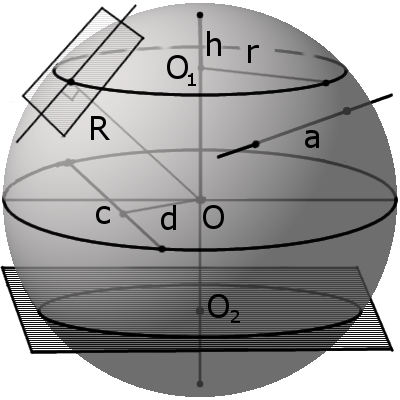
Определение.
Шар — это совокупность всех точек в трехмерном пространстве, расстояние от которых не превышает определенного расстояния до точки, называемой центром шара (О) (совокупность всех точек трехмерного пространства ограниченных сферой).Шар можно описать как объёмную фигуру, которая образуется вращением круга вокруг своего диаметра на 180° или полуокружности вокруг своего диаметра на 360°.
Определение. Радиус сферы (шара) (R) — это расстояние от центра сферы (шара) O к любой точке сферы (поверхности шара).
Определение. Диаметр сферы (шара) (D) — это отрезок, соединяющий две точки сферы (поверхности шара) и проходящий через ее центр.
Формула. Объём шара: Формула. Площадь поверхности сферы через радиус или диаметр:S = 4πR2 = πD2
Уравнение сферы
1. Уравнение сферы с радиусом R и центром в начале декартовой системе координат:x2 + y2 + z2 = R2
2. Уравнение сферы с радиусом R и центром в точке с координатами (x0, y0, z0) в декартовой системе координат:(x — x0)2 + (y — y0)2 + (z — z0)2 = R2
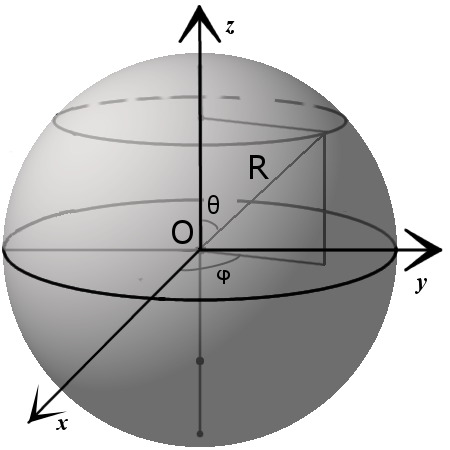 3. Параметрическое уравнение сферы с центром в точке (x0, y0, z0):
3. Параметрическое уравнение сферы с центром в точке (x0, y0, z0): x = x0 + R · sin θ · cos φ y = y0 + R · sin θ · sin φ z = z0 + R · cos θ
где θ ϵ [0,π], φ ϵ [0,2π].
Определение. Диаметрально противоположными точками называются любые две точки на поверхности шара (сфере), которые соединены диаметром.
Основные свойства сферы и шара
1. Все точки сферы одинаково удалены от центра.
2. Любое сечение сферы плоскостью является окружностью.
3. Любое сечение шара плоскостью есть кругом.
4. Сфера имеет наибольший объём среди всех пространственных фигур с одинаковой площадью поверхности.
5. Через любые две диаметрально противоположные точки можно провести множество больших окружностей для сферы или кругов для шара.
6. Через любые две точки, кроме диаметрально противоположных точек, можно провести только одну большую окружность для сферы или большой круг для шара.
7. Любые два больших круга одного шара пересекаются по прямой, проходящей через центр шара, а окружности пересекаются в двух диаметрально противоположных точках.
8. Если расстояние между центрами любых двух шаров меньше суммы их радиусов и больше модуля разности их радиусов, то такие шары пересекаются, а в плоскости пересечения образуется круг.
Секущая, хорда, секущая плоскость сферы и их свойства
Определение. Секущая сферы — это прямая, которая пересекает сферу в двух точках. Точки пересечения называются точками протыкания поверхности или точками входа и выхода на поверхности.
Определение. Хорда сферы (шара) — это отрезок, соединяющий две точки сферы (поверхности шара).
Определение. Секущая плоскость — это плоскость, которая пересекает сферу.
Определение. Диаметральная плоскость — это секущая плоскость, проходящая через центр сферы или шара, сеченме образует соответственно большую окружность и большой круг. Большая окружность и большой круг имеют центр, который совпадают с центром сферы (шара).
Любая хорда, проходящая через центр сферы (шара) является диаметром.
Хорда является отрезком секущей прямой.
Расстояние d от центра сферы до секущей всегда меньше чем радиус сферы:d < R
Расстояние m между секущей плоскостью и центром сферы всегда меньше радиуса R:m < R
Местом сечения секущей плоскости на сфере всегда будет малая окружность, а на шаре местом сечения будет малый круг. Малая окружность и малый круг имеют свои центры, не совпадающих с центром сферы (шара). Радиус r такого круга можно найти по формуле:r = √R2 — m2,
где R — радиус сферы (шара), m — расстояние от центра шара до секущей плоскости.Определение. Полусфера (полушар) — это половина сферы (шара), которая образуется при ее сечении диаметральной плоскостью.
Касательная, касательная плоскость к сфере и их свойства
Определение.Касательная к сфере — это прямая, которая касается сферы только в одной точке.
Определение.Касательная плоскость к сфере — это плоскость, которая соприкасается со сферой только в одной точке.
Касательная пряма (плоскость) всегда перпендикулярна радиусу сферы проведенному к точке соприкосновения
Расстояние от центра сферы до касательной прямой (плоскости) равно радиусу сферы.
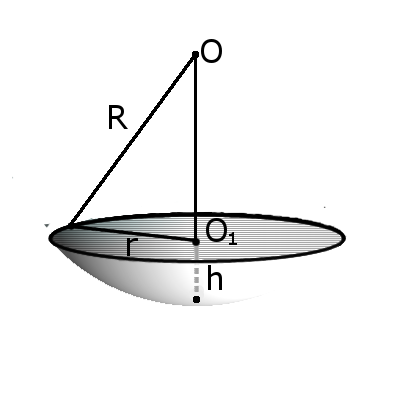 Определение. Сегмент шара — это часть шара, которая отсекается от шара секущей плоскостью. Основой сегмента называют круг, который образовался в месте сечения. Высотой сегмента h называют длину перпендикуляра проведенного с середины основы сегмента к поверхности сегмента. Формула. Площадь внешней поверхности сегмента сферы с высотой h через радиус сферы R:
Определение. Сегмент шара — это часть шара, которая отсекается от шара секущей плоскостью. Основой сегмента называют круг, который образовался в месте сечения. Высотой сегмента h называют длину перпендикуляра проведенного с середины основы сегмента к поверхности сегмента. Формула. Площадь внешней поверхности сегмента сферы с высотой h через радиус сферы R:S = 2πRh
Формула. Объём сегмента сферы с высотой h через радиус сферы R: Определение. Срез шара — это часть шара, которая образуется в результате его сечения двумя параллельными плоскостями и находится между ними.
Определение. Срез шара — это часть шара, которая образуется в результате его сечения двумя параллельными плоскостями и находится между ними.
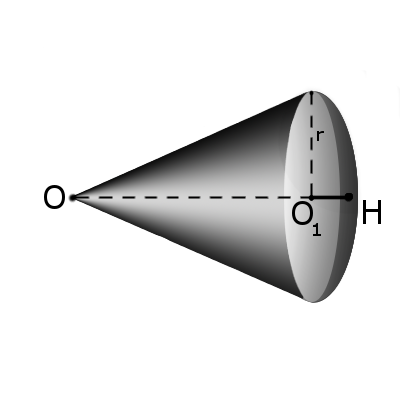 Определение. Сектором называется часть шара, ограниченная совокупностью всех лучей, исходящих из центра шара О и образующих круг на его поверхности с радиусом r. Формула. Площадь поверхности сектора S с высотой O1H (h) через радиус шара OH (R):
Определение. Сектором называется часть шара, ограниченная совокупностью всех лучей, исходящих из центра шара О и образующих круг на его поверхности с радиусом r. Формула. Площадь поверхности сектора S с высотой O1H (h) через радиус шара OH (R):S = πR(2h + √2hR — h2)
Формула. Объём сектора V с высотой O1H (h) через радиус шара OH (R):Определение. Касательными сферами (шарами) называются любые две сферы (шара), которые имеют одну общую точку соприкосновения. Если расстояние между центрами больше суммы радиусов, то фигуры не касаются и не пересекаются.
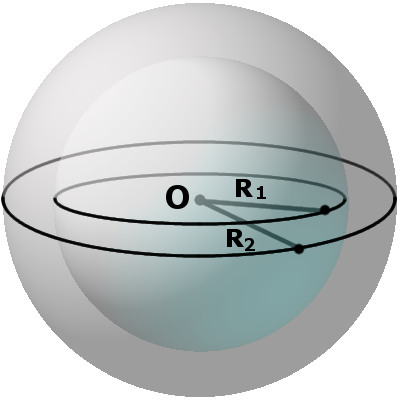 Определение. Концентрическими сферами называются любые две сферы, которые имеют общий центр и радиусы различной длины.
Определение. Концентрическими сферами называются любые две сферы, которые имеют общий центр и радиусы различной длины.
Как найти радиус окружности — Лайфхакер
Выбирайте формулу в зависимости от известных величин.
Через площадь круга
- Разделите площадь круга на число пи.
- Найдите корень из результата.
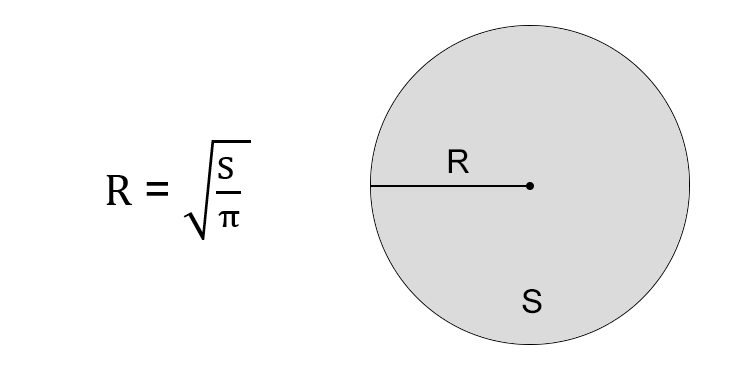 Иллюстрация: Лайфхакер
Иллюстрация: Лайфхакер- R — искомый радиус окружности.
- S — площадь круга. Напомним, кругом называют плоскость внутри окружности.
- π (пи) — константа, равная 3,14.
Сейчас читают 🔥
Через длину окружности
- Умножьте число пи на два.
- Разделите длину окружности на результат.
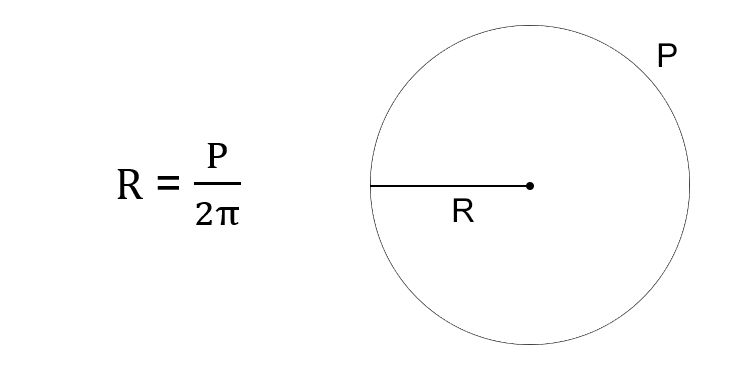 Иллюстрация: Лайфхакер
Иллюстрация: Лайфхакер- R — искомый радиус окружности.
- P — длина окружности (периметр круга).
- π (пи) — константа, равная 3,14.
Через диаметр окружности
Если вы вдруг забыли, радиус равняется половине диаметра. Поэтому, если диаметр известен, просто разделите его на два.
 Иллюстрация: Лайфхакер
Иллюстрация: Лайфхакер- R — искомый радиус окружности.
- D — диаметр.
Через диагональ вписанного прямоугольника
Диагональ прямоугольника является диаметром окружности, в которую он вписан. А диаметр, как мы уже вспомнили, в два раза больше радиуса. Поэтому достаточно разделить диагональ на два.
 Иллюстрация: Лайфхакер
Иллюстрация: Лайфхакер- R — искомый радиус окружности.
- d — диагональ вписанного прямоугольника. Напомним, она делит фигуру на два прямоугольных треугольника и является их гипотенузой — стороной, лежащей напротив прямого угла. Поэтому, если диагональ неизвестна, её можно найти через соседние стороны прямоугольника с помощью теоремы Пифагора.
- a, b — стороны вписанного прямоугольника.
Через сторону описанного квадрата
Сторона описанного квадрата равна диаметру окружности. А диаметр — повторимся — равен двум радиусам. Поэтому разделите сторону квадрата на два.
 Иллюстрация: Лайфхакер
Иллюстрация: Лайфхакер- r — искомый радиус окружности.
- a — сторона описанного квадрата.
Через стороны и площадь вписанного треугольника
- Перемножьте три стороны треугольника.
- Разделите результат на четыре площади треугольника.
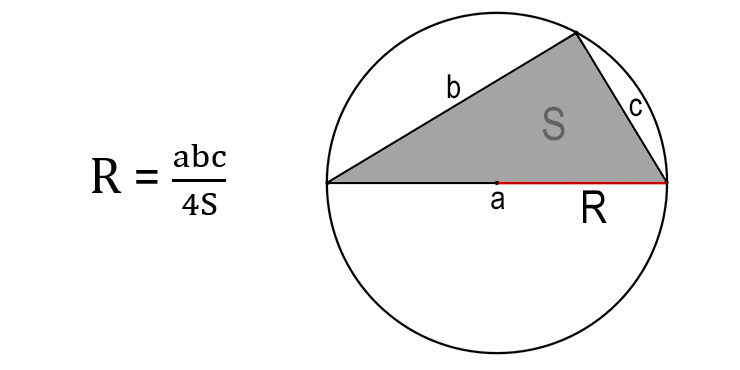
Через площадь и полупериметр описанного треугольника
Разделите площадь описанного треугольника на его полупериметр.
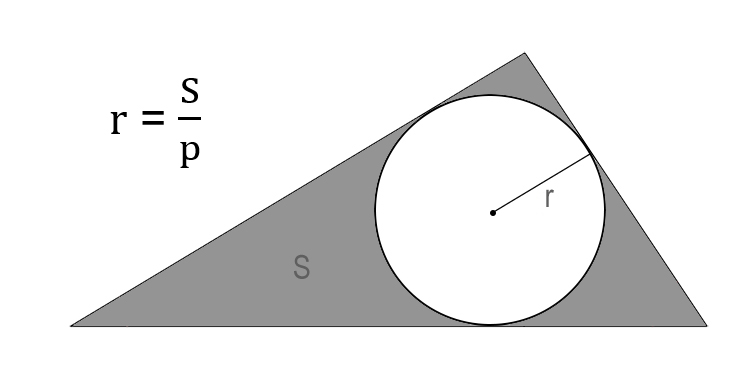 Иллюстрация: Лайфхакер
Иллюстрация: Лайфхакер- r — искомый радиус окружности.
- S — площадь треугольника.
- p — полупериметр треугольника (равен половине от суммы всех сторон).
Через площадь сектора и его центральный угол
- Умножьте площадь сектора на 360 градусов.
- Разделите результат на произведение пи и центрального угла.
- Найдите корень из полученного числа.
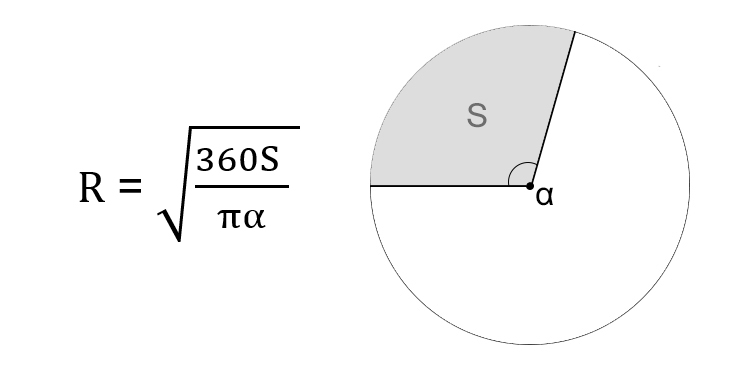 Иллюстрация: Лайфхакер
Иллюстрация: Лайфхакер- R — искомый радиус окружности.
- S — площадь сектора круга.
- α — центральный угол.
- π (пи) — константа, равная 3,14.
Через сторону вписанного правильного многоугольника
- Разделите 180 градусов на количество сторон многоугольника.
- Найдите синус полученного числа.
- Умножьте результат на два.
- Разделите сторону многоугольника на результат всех предыдущих действий.
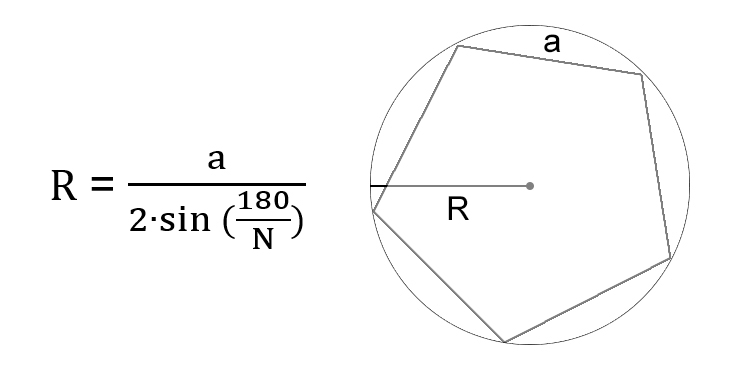
- R — искомый радиус окружности.
- a — сторона правильного многоугольника. Напомним, в правильном многоугольнике все стороны равны.
- N — количество сторон многоугольника. К примеру, если в задаче фигурирует пятиугольник, как на изображении выше, N будет равняться 5.



